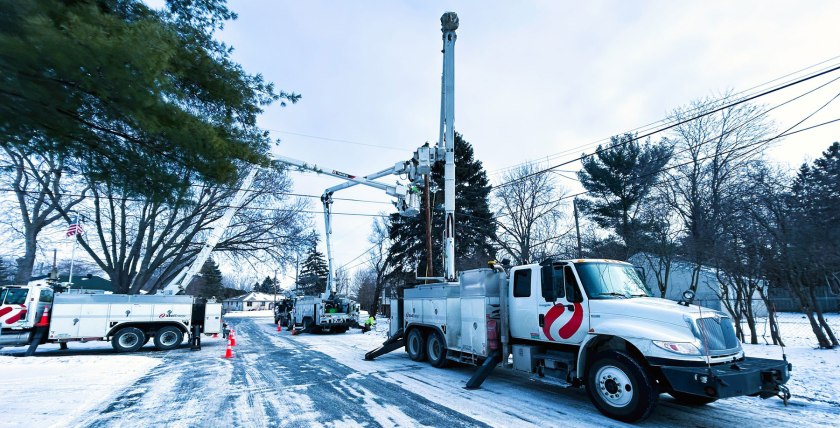Thanks to The North 40 Tavern for their support. A north woods tavern somewhere in the middle of a big city. They regularly rotate tap beers, so stop in to see what’s currently flowing.
Some West St. Paul residents have seen as many as three or four power outages over the past few months, despite calm and often unusually mild weather. So what’s going on? We contacted Xcel Energy and looked into the issue.
Short version: It’s not rolling blackouts or increased demand from new development. It’s an unfortunate combination of routine maintenance and unexpected but common failures.
What’s normal: The electrical grid, like any complex system, is never going to be 100% reliable. Xcel Energy says its customers can expect to see on average about one outage per year outside of “major event days” such as severe weather.
Recent outages: We asked about five outages in the past several months that impacted a large number of customers in and around West St. Paul—November 15 (two outages totaling 40 minutes), December 25 (56 minutes), January 14 (3 hours), January 19 (1 hour and 10 minutes), and January 30 (59 minutes).
The Explanation From Xcel
Xcel spokesman Kevin Coss said the utility is still investigating, but they do know that in each of these outages, equipment failure was to blame. For example, the December 25 outage was caused by a fire on a pole in Mendota Heights; and concurrent with the January 14 outages, residents reported someone drove their car into a power pole near Logan and Calumet.
While Coss didn’t offer specifics beyond that, there are a lot of components on the grid that can wear out or fail, and collectively that is the most common cause of non-weather related outages.
Under normal circumstances, those failures might only affect a handful of customers. But Coss explained that the primary substation that serves the West St. Paul area is undergoing scheduled maintenance, which means power is being routed through other parts of the system.
“Any outages that affect those substations would impact more customers during this maintenance work than they would when the system is configured normally,” Coss said.
That work began in late November, and is scheduled to wrap up by April.
“Shifting which substations serve which customers is dynamic, and it is temporary,” Coss said. “We use alternate configurations to safely provide power to as many customers as possible until we can return to the normal configuration.”
Were these “rolling blackouts?”
In a word, no.
The term “rolling blackouts” specifically refers to conditions when electricity demand exceeds supply. The outages can be ordered by the regional grid operator to conserve power, as in California in 2020, or result from widespread power plant failure, as in Texas in 2021.
Unlike California, where the grid is largely isolated from the rest of the country by geography; and Texas, which has its own independent grid because, well, Texas; Minnesota benefits from being part of a large regional grid serving multiple states—the Midcontinent Independent System Operator, or MISO. While Xcel is responsible for keeping the vast array of local distribution and feeder lines running, MISO has exactly one job—to make sure there is enough power. If a power plant goes offline unexpectedly, for instance, its dispatchers can redirect flow through transmission lines and order individual generation sources to ramp up and down as needed.
In winter in Minnesota, electricity demand is pretty low, and MISO spokesperson Brandon Morris confirmed that there was plenty of electricity to go around during the recent spate of local outages.
And while utilities sometimes issue conservation warnings and deploy other technology to curb demand during summer peaks, MISO has never ordered rolling blackouts in Minnesota, Morris said.
What about all the apartment buildings?
West St. Paul has seen a lot of new business and residential development in the past few years, causing some to point a finger at new apartment buildings.
It’s not unreasonable to ask whether this additional load has been a factor in the recent string of outages. But apartment buildings are far less energy-intensive per square foot than other commercial properties like fast-food restaurants or supermarkets. Based on rough calculations the largest new multifamily buildings in West St. Paul would be expected to use half the energy of, say, a Target superstore.
Also, before any new development can be connected to electric and gas service, it must file an application with Xcel to ensure there is enough grid capacity to serve the load. City Planner Melissa Houtsma said she is not aware of any instance where Xcel needed to reject plans for a new development. And in most cases these projects were preceded by other heavy energy users—a big-box store and indoor shopping mall at Signal Hills, for instance, or the YMCA near the site of the new Westlyn.
However local electricity demand may have changed, Coss said it “is not a primary concern for the recent outages.”
Moving Forward
While Xcel can identify which piece of equipment failed and replace it to restore power, that’s not the same thing as knowing exactly why something failed, Coss said. That’s why the utility’s investigation is ongoing.
“We are actively looking into the outages to understand more about what caused the equipment issues and to ensure we can better serve the community going forward,” he said. “We know frequent outages can be frustrating and inconvenient and thank residents and businesses in the area for their patience.”
Stories like this happen thanks to our members. Join now to support neighborhood news.
Photo by Carlo James LaManna.

